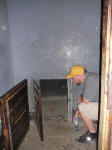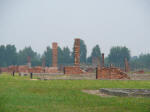| Auschwitz | ||
| July 14 | ||
|
For more information on Auschwitz-Birkenau Concentration Camps,
please view the official site of the museum here. For general
information on the Holocaust, here is a link to the
US Holocaust Memorial Museum in
Washington DC. Going to Auschwitz was the third time I have been to
something like this (Dachau in 1994, Washington DC museum, and now
Auschwitz.) They are all different, yet share many similarities,
including similar displays. Both the feeling you have when you see
them is always the same. A frequently paraphrased quote that is very appropriate and appears at the entrance to Block 11 at Auschwitz I should be known and remembered by all. Once you read this, then you can move on the pictures below. "The one who does not remember history is bound to live through it again" |
||
 |
 |
 |
|
"Arbeit Macht Frei" Work Will Set You Free |
This plaque appears at the memorial at Auschwitz II-Birkenau. There is a plaque in every language that was spoken by a prisoner-victim of the camps. | There were many of these double rows of electrified-barbed wire fences throughout the complexes. |
 |
 |
 |
| The Nazis shaved the hair off of the women prisoner-victims and used the hair for industrial purposes. | Andrew crouches near the entrance to one of the standing cells, which were used to punish prisoners. Four to seven prisoners were placed in each cell and the size of the cell only allowed them to stand all night after working 10 hour days. | Another row of barbed wire fence |
|
One of the most striking things to us was the systematic efficiency that
the Nazis employed. They shaved the heads of the women to use their
hair. They pulled the gold teeth out of the victims before cremating
them to use the gold in the war effort.
The trickery went so far that the Nazis told the prisoners to place their names on their suitcases so that they could reclaim them after taking their "shower." They never returned from this shower as the showers were actually the gas chambers where over 2000 prisoners were executed at the same time. The overall number of victims of Auschwitz in the years 1940-1945 is estimated at between 1,100,000 and 1,500,000 people. The majority of them, and above all the mass transports of Jews who arrived beginning in 1942, died in the gas chambers. |
||
 |
 |
 |
| The handicapped were unable to work and quickly executed after arriving at the camp. Their crutches and prosthetic limbs were saved for use by the Nazis | The Death Wall outside Block 11 was used as the location of the firing squad. The windows of the adjacent blocks were shuttered so the prisoners could not see, but could hear, the executions. | Canisters of Zyklon B that were located after the liberation. Zyklon tablets were dropped into the "showers" and over 15-20 minutes killed the victims who thought they were being forced to take a shower. |
|
Below are pictures of Auschwitz II - Birkenau, which was much larger than the original Auschwitz. Auschwitz is the German word for the Polish town of Oswiecim, where the original camp was located. Birkenau was the name of the town in which the larger camp was located. |
||
 |
 |
 |
| The entrance to the camp | The train tracks ran right through the entrance, making the transport of prisoners quick and efficient | As if one track wasn't enough, the Nazis placed three tracks |
 |
 |
 |
|
Rudolf Hess, first
commandant of the camp was hanged at the camp and the gallows and a sign
mark the sign. Click to read more. (your browser may resize the photo automatically. move cursor to lower right of the picture (after you click on this one) and click the expand button to read the text. |
The chimneys mark where many barracks were located before the Nazis destroyed them in an attempt to hide evidence of their existence before the Soviet Army liberated the camp | You can see the full barracks, which were actually German horse stables, and the chimneys of the many more which previously stood there. |